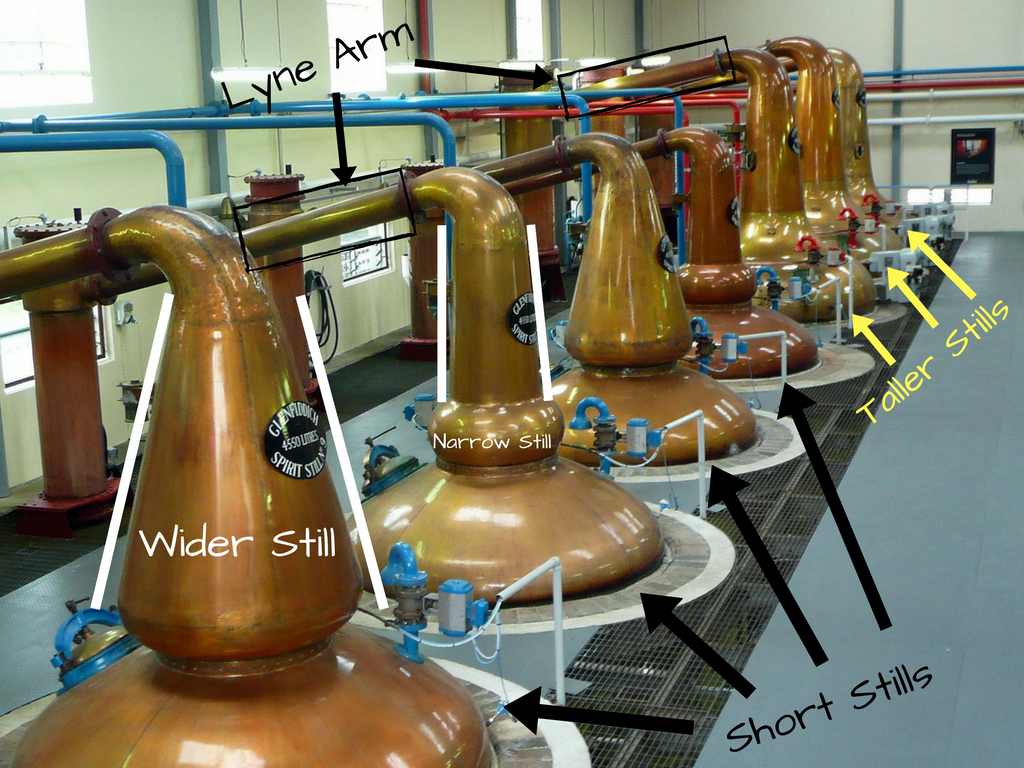Ah, the still. Whiskey wouldn’t exist without this piece of equipment. And yet, when we start talking about a whiskey’s flavor, the still is oft forgotten. While mash bills and barrel type take the spotlight, the still is quietly working hard in the background. Let’s take a moment to recognize the still’s qualities and contributions. There are a few different types of still. They all make whiskey in slightly different ways. In this article, we’re going to look at pot stills and how their shape changes how your whiskey tastes.
Pot stills are the most basic type of still. You put what is essentially beer in the pot part and heat it until the alcohol changes from a liquid into a gas at about 173 degrees Fahrenheit. Then as the alcohol vapors rise up they’re captured at the top of the still and directed down the lyne arm and to the condenser. In the condenser, the vapors are cooled back into a liquid and out comes alcohol. That’s a simplified version of the process, but you get the idea.
Really, distillation is all about the alcohol vapors. How quickly the vapor forms, how much it has to rise, how much copper it touches, and how quickly it’s cooled will affect the way your whiskey tastes. The shape of the still dictates all of the vapor interaction.
Now let’s talk about specific characteristics and what they typically mean for taste and flavor. In the picture below we have three taller stills, four shorter stills, and two variations in shape on the shorter stills.

Tall Stills vs. Short Stills
In theory, only ethanol (alcohol) vapors would rise up at 173°. The fact is, though, that other things hitch a ride on the vapor stream. Things like esters, phenols, fusel alcohols and some other stuff. All of these things contribute to the final flavor of your whiskey. So what does the height of the still have to do with it?
These “other things” are heavier than ethanol vapors. They can steal a ride for only so long before the ethanol vapors ditch them. That means shorter stills allow more things over the top and taller stills give the ethanol more time to separate from the hitchhikers.
One type of still is not better than the other. They’re just different. Shorter pot stills deliver heavier flavored, more palate clinging whiskey. And taller pot stills will give you more indistinct lighter whiskeys. It’s all a matter of preference.
Wider Stills vs. Narrower Stills
In the picture, you’ll notice that there are two different shapes to the shorter stills. A set of wider and a set of narrower stills. How does this shape difference affect flavor? Two ways.
First, copper strips out some undesirable sulfurs from the distillate. The more the ethanol interacts with copper the more these sulfurs get stripped out. Second, the more surface area a still has the more esters, phenols, and fusel alcohols get knocked off the vapor stream and fall back into the pot.
Since wider stills have more surface area than the narrow stills, they tend to produce a less oily and more refined spirit than their skinnier counterparts. Again, one isn’t better than the other. They’re just different.
So what did we learn in this article? Shorter stills with less copper will produce heavier whiskey with more oils, while taller stills with more copper will produce a lighter tasting spirit. As far as flavor is concerned, still size and shape play a big role. Take that grains and casks!
— Zac Smith


